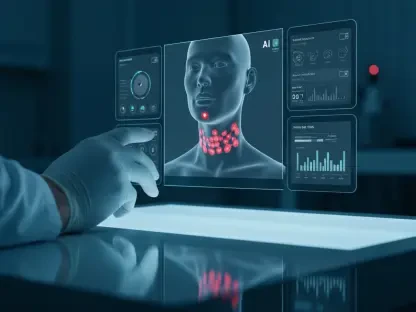The year 2024 has been a tumultuous one for Health New Zealand – Te Whatu Ora’s Data & Digital division, with the organization grappling with numerous challenges ranging from significant budget cuts to leadership upheavals. These issues have hindered the much-needed advancements in the country’s digital health agenda. These hurdles paint a picture reminiscent of Queen Elizabeth II’s annus horribilis, where crises and upheaval took center stage. However, despite the myriad of obstacles that surfaced throughout the year, there were still moments of notable progress and groundbreaking innovation that provided hope for a more promising future in New Zealand’s healthcare ecosystem.
A Year of Crises and Upheaval
2024 was marked by a confluence of significant obstacles for Health New Zealand’s Data & Digital division, with major project plans being scrapped and the future clouded by uncertainty. The division’s struggles, characterized by crises and upheavals, seemed almost insurmountable. Amidst the turmoil, some industry stakeholders have called for a reset and the optimization of current resources to yield better outcomes. The year began on a positive note with InterSystems testing a FHIR-based API for the National Health Index, which is part of Health NZ’s Hira program aimed at modernizing patient administration systems in Auckland’s hospitals. Another commendable effort came from Te Tai Tokerau Northland, which promoted patient portal access through their Digital On-Road Access (DORA) bus. However, this early promise quickly gave way to challenges, such as a damaging data leak authored by a former IT staffer, compromising personal information of 12,000 individuals.
These events illustrate the high-stakes environment within which Health New Zealand’s Data & Digital division operates. The data breach, in particular, highlighted vulnerabilities that had serious implications for public trust and the integrity of the healthcare system. Earlier in the year, before the leadership turmoil began, Data & Digital chief Leigh Donoghue had presented a compelling vision for the division’s modernization program. This program aimed to make significant strides within constrained resources, particularly focusing on the Hira program and forthcoming AI initiatives. However, the division’s momentum was stymied by the realities of working within a fragmented data environment, which saw over 4,000 outdated systems in operation. Additionally, the GP2GP patient record transfer system faced significant condemnation due to its high failure rate, with modernization efforts seemingly unable to deliver the necessary results.
Bright Spots Amidst the Challenges
Despite the numerous difficulties encountered throughout the year, there were several bright spots that indicated the potential for positive transformation in New Zealand’s digital healthcare landscape. One of the most notable achievements was the development of the NZ Patient Summary, an internationally recognized initiative spearheaded by HL7 New Zealand. This project aimed to create a comprehensive summary of patient health information, which could be accessible across various healthcare settings. However, concerns persisted about the sustainability of this project due to ongoing budget constraints. Likewise, digital wayfinding and patient flow management projects at the new Dunedin Hospital garnered attention and are expected to endure despite financial limitations.
In parallel, 2024 witnessed the emergence of AI-driven solutions in healthcare, with general practitioners (GPs) adopting Nabla Copilot for medical speech-to-text conversions. This innovative tool significantly streamlined clinical documentation processes. Other noteworthy developments included myPractice’s Second Opinion technology and ProCare’s deployment of digital assistants to handle administrative burdens in general practices. ProCare introduced five robots focusing on tasks such as inbox management and cardiovascular disease risk assessments, exemplifying the potential of AI to revolutionize healthcare delivery in New Zealand by improving efficiency and accuracy.
Contentious Struggles in the PMS Sector
The Practice Management System (PMS) sector, however, was not without its share of challenges. The rivalry between Medtech and Indici turned into a contentious and resource-draining struggle. Instead of focusing on the development and enhancement of their respective technologies, both companies found themselves entangled in legal battles that diverted attention and resources away from meaningful progress. This conflict did not only cost both companies significantly in terms of financial resources but also stalled innovation and development efforts, delaying the advancement of the entire sector.
A particularly difficult issue faced by Health New Zealand was the significant budget cuts that further destabilized crucial projects. The Hira health information sharing program and patient record technologies were deeply affected, with a $330 million reduction in funds forcing the division to halt or scale back various initiatives. This reduction in funding also impacted other innovative plans, such as the comprehensive patient records envisioned under the NZ Patient Summary project. The financial strain created additional hurdles for the Data & Digital division, compounding the existing challenges and undermining efforts to modernize and streamline healthcare services.
AI Adoption and Technological Innovations
Interestingly, amidst these financial and operational setbacks, there was a noticeable trend in the adoption of AI technologies across general practices in New Zealand. More than 50 percent of general practices reported using AI for administrative tasks, and about a quarter utilized these technologies on a daily basis. Diagnostic tools and predictive analytics became increasingly relied upon, showcasing the growing influence and integration of AI in the healthcare sector. Successful data integration across previously fragmented District Health Board (DHB) systems into the National Data Platform (NDP) was another milestone achievement, although this accomplishment was somewhat overshadowed by the concurrent leadership upheavals within the division.
Key technological innovations continued to surface in 2024. Health NZ Waikato rolled out the non-clinical Smartpage for attendance management, and Core Schedule developed a virtual care solution for telehealth. Medtech, for its part, engaged in a collaboration to deliver real-time radiology reports via their API. These advancements highlighted the role of technology in enhancing healthcare delivery and underscored the critical need for robust and consistent investment in digital health infrastructure.
Leadership Challenges and Budget Constraints
Leadership challenges and budget constraints were major stumbling blocks for Health New Zealand throughout the year. The exits of key personnel such as Leigh Donoghue and Kari Jones created periods of instability, and leadership assurances on data security were insufficient to quell the growing concerns amid stringent budget restraints. The looming financial constraints forced the division to undertake structural reductions and job cuts, further exacerbating the situation.
Amidst these challenges, new solutions continued to emerge. ProCare’s digital assistants for administrative tasks in general practices, Ryman’s PillDrop medication delivery service for retirement villages, and a Starlink-supported mobile internet solution for remote healthcare workers were among the innovative responses designed to address the evolving needs of the healthcare sector. These innovations offered a glimpse into the potential of technology to alleviate some of the pressures faced by the sector and underscored the critical importance of nurturing and investing in such advancements.
The Path Forward
The year 2024 has been quite challenging for Health New Zealand – Te Whatu Ora’s Data & Digital division. The organization has faced a host of issues, including substantial budget cuts and significant leadership changes. These setbacks have slowed progress in advancing the country’s digital health agenda. This turbulent period is reminiscent of Queen Elizabeth II’s annus horribilis, marked by crises and upheavals. Despite the numerous obstacles encountered over the year, there were still instances of notable progress and significant innovations. These achievements have provided a glimmer of hope for a more positive future in New Zealand’s healthcare system.
While the challenges have been significant, the resilience and dedication of those within Health New Zealand have led to some noteworthy accomplishments. The continued push towards integrating cutting-edge technology and innovative solutions has not gone unnoticed. This period of growth amidst adversity shows promise for the future of healthcare in New Zealand, with the potential for these advancements to have a lasting impact on the nation’s overall health and wellbeing. The journey has been tough, but the strides made affirm that a brighter future for digital health in New Zealand is within reach.









